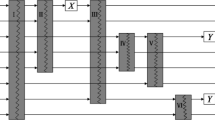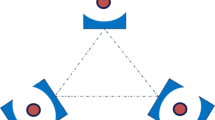Abstract
By Lyapunov control, we present a protocol to prepare entangled states such as Bell states in the context of cavity QED system. The advantage of our method is of threefold. Firstly, we can only control the phase of classical fields to complete the preparation process. Secondly, the evolution time is sharply shortened when compared to adiabatic control. Thirdly, the final state is steady after removing control fields. The influence of decoherence caused by the atomic spontaneous emission and the cavity decay is discussed. The numerical results show that the control scheme is immune to decoherence, especially for the atomic spontaneous emission from \(|2\rangle \) to \(|1\rangle \). This can be understood as the state staying in an invariant subspace. Finally, we generalize this method in preparation of W state.





Similar content being viewed by others
References
Nielsen, M.A., Chuang, I.L.: Quantum Computation and Quantum Information. Cambridge University Press, Cambridge (2000)
Domokos, P., Raimond, J.M., Brune, M., Haroche, S.: Simple cavity-QED two-bit universal quantum logic gate: the principle and expected performances. Phys. Rev. A 52, 3554 (1995)
Pellizzari, T., Gardiner, S.A., Cirac, J.I., Zoller, P.: Decoherence, continuous observation, and quantum computing: a cavity QED model. Phys. Rev. Lett. 75, 3788 (1995)
Zheng, S.B., Guo, G.C.: Efficient scheme for two-atom entanglement and quantum information processing in cavity QED. Phys. Rev. Lett. 85, 2392 (2000)
Pachos, J., Walther, H.: Quantum computation with trapped ions in an optical cavity. Phys. Rev. Lett. 89, 187903 (2002)
Banchi, L., Bayat, A., Verrucchi, P., Bose, S.: Nonperturbative entangling gates between distant qubits using uniform cold atom chains. Phys. Rev. Lett. 106, 140501 (2011)
Unanyan, R.G., Vitanov, N.V., Bergmann, K.: Preparation of entangled states by adiabatic passage. Phys. Rev. Lett. 87, 137902 (2001)
Malinovsky, V.S., Sola, I.R.: Quantum control of entanglement by phase manipulation of time-delayed pulse sequences. Phys. Rev. A 70, 042304 (2004)
Creatore, C., Brierley, R.T., Phillips, R.T., Littlewood, P.B., Eastham, P.R.: Creation of entangled states in coupled quantum dots via adiabatic rapid passage. Phys. Rev. B 86, 155442 (2012)
Chakhmakhchyan, L., Leroy, C., Ananikian, N., Guérin, S.: Generation of entanglement in systems of intercoupled qubits. Phys. Rev. A 90, 042324 (2014)
Beige, A., Braun, D., Tregenna, B., Knight, P.L.: Quantum computing using dissipation to remain in a decoherence-free subspace. Phys. Rev. Lett. 85, 1762 (2000)
Browne, D.E., Plenio, M.B., Huelga, S.F.: Robust creation of entanglement between ions in spatially separate cavities. Phys. Rev. Lett. 91, 067901 (2003)
Marr, C., Beige, A., Rempe, G.: Entangled-state preparation via dissipation-assisted adiabatic passages. Phys. Rev. A 68, 033817 (2003)
Metz, J., Trupke, M., Beige, A.: Robust entanglement through macroscopic quantum jumps. Phys. Rev. Lett. 97, 040503 (2006)
Wang X.T., Schirmer, S.G.: Generating maximal entanglement between non-interacting atoms by collective decay and symmetry breaking. arXiv:1005.2114, (2010)
Kastoryano, M.J., Reiter, F., Sorensen, A.S.: Dissipative preparation of entanglement in optical cavities. Phys. Rev. Lett. 106, 090502 (2011)
Busch, J., De, S., Ivanov, S.S., Torosov, B.T., Spiller, T.P., Beige, A.: Cooling atom-cavity systems into entangled states. Phys. Rev. A 84, 022316 (2011)
Schneider, S., Milburn, G.J.: Entanglement in the steady state of a collective-angular-momentum (Dicke) model. Phys. Rev. A 65, 042107 (2002)
Kraus, B., Büchler, H.P., Diehl, S., Kantian, A., Micheli, A., Zoller, P.: Preparation of entangled states by quantum Markov processes. Phys. Rev. A 78, 042307 (2008)
Vacanti, G., Beige, A.: Cooling atoms into entangled states. New J. Phys. 11, 083008 (2009)
Verstraete, F., Wolf, M.M., Cirac, J.I.: Quantum computation and quantum-state engineering driven by dissipation. Nat. Phys. 9, 633 (2009)
Cho, J., Bose, S., Kim, M.S.: Optical pumping into many-body entanglement. Phys. Rev. Lett. 106, 020504 (2011)
Beauchard, K., Coron, J.M., Mirrahimi, M., Rouchon, P.: Implicit Lyapunov control of finite dimensional Schrödinger equations. Syst. Control Lett. 56, 388 (2007)
Coron, J.M., Grigoriu, A., Lefter, C., Turinici, G.: Quantum control design by Lyapunov trajectory tracking for dipole and polarizability coupling. New J. Phys. 11, 105034 (2009)
Wang, X.T., Schirmer, S.G.: Entanglement generation between distant atoms by Lyapunov control. Phys. Rev. A 80, 042305 (2009)
Wang, X.T., Bayat, A., Bose, S., Schirmer, S.G.: Global control methods for Greenberger–Horne–Zeilinger-state generation on a one-dimensional Ising chain. Phys. Rev. A 82, 012330 (2010)
Hou, S.C., Khan, M.A., Yi, X.X., Dong, D.Y., Petersen, I.R.: Optimal Lyapunov-based quantum control for quantum systems. Phys. Rev. A 86, 022321 (2012)
Shi, Z.C., Zhao, X.L., Yi, X.X.: Preparation of topological modes by Lyapunov control. Sci. Rep. 5, 13777 (2015)
D’Alessandro, D.: Introduction to Quantum Control and Dynamics. Taylor and Francis Group, Boca Raton (2007)
Kuang, S., Cong, S.: Lyapunov control methods of closed quantum systems. Automatica 44, 98 (2008)
Duan, L.M., Cirac, J.I., Zoller, P.: Geometric manipulation of trapped ions for quantum computation. Science 292, 1695 (2001)
Barreiro, J.T., Müller, M., Schindler, P., Nigg, D., Monz, T., Chwalla, M., Hennrich, M., Roos, C.F., Zoller, P., Blatt, R.: An open-system quantum simulator with trapped ions. Nature 470, 486 (2011)
Yang, C.P., Chu, S.I., Han, S.: Quantum information transfer and entanglement with SQUID qubits in cavity QED: a dark-state scheme with tolerance for nonuniform device parameter. Phys. Rev. Lett. 92, 117902 (2004)
Neumann, P., Mizuochi, N., Rempp, F., Hemmer, P., Watanabe, H., Yamasaki, S., Jacques, V., Gaebel, T., Jelezko, F., Wrachtrup, J.: Multipartite entanglement among single spins in diamond. Science 320, 1326 (2008)
Li, X.Q., Wu, Y.W., Steel, D.G., Gammon, D., Stievater, T.H., Katzer, D.S., Park, D., Piermarocchi, C., Sham, L.J.: An all-optical quantum gate in a semiconductor quantum dot. Science 301, 809 (2003)
Reithmaier, J.P., Sek, G., Löffler, A., Hofmann, C., Kuhn, S., Reitzenstein, S., Keldysh, L.V., Kulakovskii, V.D., Reinecke, T.L., Forchel, A.: Strong coupling in a single quantum dot-semiconductor microcavity system. Nature 432, 197 (2004)
Blattmann, R., Krenner, H.J., Kohler, S., Hänggi, P.: Entanglement creation in a quantum-dot-nanocavity system by Fourier-synthesized acoustic pulses. Phys. Rev. A 89, 012327 (2014)
Vitanov, N.V., Suominen, K.A., Shore, B.W.: Creation of coherent atomic superpositions by fractional stimulated Raman adiabatic passage. J. Phys. B Atom. Mol. Opt. Phys. 32, 4535 (1999)
Amniat-Talab, M., Guérin, S., Sangouard, N., Jauslin, H.R.: Atom-photon, atom-atom, and photon-photon entanglement preparation by fractional adiabatic passage. Phys. Rev. A 71, 023805 (2005)
Boca, A., Miller, R., Birnbaum, K.M., Boozer, A.D., Mckeever, J., Kimble, H.J.: Observation of the vacuum Rabi spectrum for one trapped atom. Phys. Rev. Lett. 93, 233603 (2004)
Breuer, H.P., Petruccione, F.: The theory of open quantum systems. Oxford University Press, Oxford (2002)
Acknowledgments
This work is supported by the National Natural Science Foundation of China (Grants No. 11534002, 61475033 and 11475037) and supported by the Fundamental Research Funds for the Central Universities under Grant No. DUT15LK26.
Author information
Authors and Affiliations
Corresponding author
Appendix
Appendix
In this physical model, we now demonstrate that the Bell state can also be achieved by fractional stimulated Raman adiabatic passage (f-STIRAP) in which the Stokes pulses and the pump pulses vanish simultaneously eventually. The system Hamiltonian reads
In the single excitation subspace, the system eigenstate with null eigenvalue can be described by
From this expression, it is straightforward to find that the eigenstate \(|\lambda _{1}\rangle \) becomes \(|10,0\rangle \) or \(|01,0\rangle \) in the absence of the classical fields, and the eigenstate \(|\lambda _{1}\rangle \) becomes the Bell state \(|\lambda _{1}\rangle =\frac{1}{\sqrt{2}}(|10\rangle +|01\rangle )\otimes |0\rangle \) if both the classical fields \(\Omega _1(t)\) and \(\Omega _2(t)\) vanish adiabatically and satisfy the condition \(\lim \limits _{t\rightarrow +\infty }\frac{\Omega _1(t)}{\Omega _2(t)}=1\). This is the main idea of f-STIRAP which is based on the adiabatical evolution of dark state.
Assume that the initial state is \(|10,0\rangle \) again. At first, the second atom is driven by Stokes pulses, and the first atom is driven by pump pulses after a certain time delay. In order to satisfy the condition \(\lim \limits _{t\rightarrow +\infty }\frac{\Omega _1(t)}{\Omega _2(t)}=1\), one can design the following waveform for the two classical fields (we can also refer to the control fields like in the main text),
Figure 6a displays the time evolution of the fidelity. Although the order of magnitude in the control fields almost equals each other in the f-STIRAP and Lyapunov control, the dynamics behaviors are quite different. We can find that the evolution time is much longer than that in Lyapunov control. This is a universal drawback for the f-STIRAP because it must be adiabatical during the whole evolution, while Lyapunov control is not restricted to this adiabatical condition. Additionally, the waveform of classical field \(\Omega _2(t)\) is superposition of two types of pulses and different from the classical field \(\Omega _1(t)\), which is required to control the temporal sequence of classical fields with high precision. Nevertheless, we can adopt a phase modulator with square pulses and only make \(\pi \) phase difference for two classical fields in Lyapunov control.
Rights and permissions
About this article
Cite this article
Shi, Z.C., Wang, L.C. & Yi, X.X. Preparing entangled states by Lyapunov control. Quantum Inf Process 15, 4939–4953 (2016). https://doi.org/10.1007/s11128-016-1441-6
Received:
Accepted:
Published:
Issue Date:
DOI: https://doi.org/10.1007/s11128-016-1441-6





